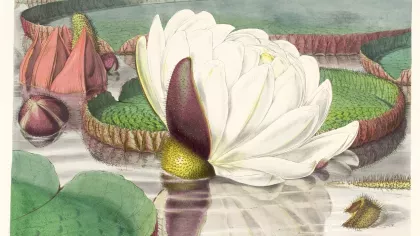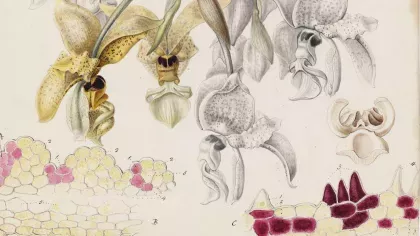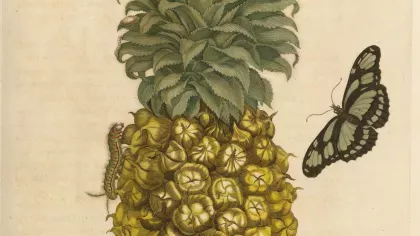17 June 2016
The art of Walter Hood Fitch
Francesca Railton from Kew's Library team looks at the work of Walter Hood Fitch, one of the most prolific botanical artists of all time.

From pattern drawer to botanical illustrator
Walter Hood Fitch was born in Glasgow in 1817. By the age of 13 he was employed as an apprentice pattern drawer at a mill. He took to botanical illustration following a meeting with William Jackson Hooker, who was so impressed by young Fitch’s artistic talents that he bought him out of his apprenticeship. Fitch went on to be an exceptionally prolific botanical illustrator, with over 12,000 of his images seeing publication.
Curtis' Botanical Magazine
Walter Hood Fitch’s prolific contribution to Curtis’ Botanical Magazine is the endeavour for which he is most often remembered. In the years that he worked at Kew, Fitch contributed over 2,700 illustrations to the magazine. The images in Curtis’ Botanical Magazine are chromolithographs (pictures printed in colour from a series of lithographic stones or plates).
Fitch’s botanical engravings were incredibly precise and therefore valuable both scientifically and aesthetically. In the days before photography botanists relied on illustrations to help with plant identification – and due to the level of detail captured by an illustration, botanists still use illustrations to aid them with plant identification. Fitch’s artistic talents led to him becoming the principle artist for Curtis’ Botanical Magazine for over forty years.
Fitch at Kew
As well as his vast contribution to Curtis’ Botanical Magazine, Fitch’s artistic talents, coupled with his close relationship with Hooker, meant that he was effectively the sole illustrator for Kew publications until 1877. One of the well-known works for which he produced images was Illustrations of British Flora, which contained numerous woodblocks of plants and constituted an illustrated companion to George Bentham’s Handbook of British Flora.
Another impressive work illustrated by Fitch is the luxury volume Victoria Regia, which depicts a number of examples of the plant Victoria regia, now known as Victoria amazonica. These water lilies are impressive specimens, with flowers often measuring more than three metres in diameter and stalks around eight metres long. They are said to be strong enough to hold the weight of a child! The images in Fitch’s work are primarily drawn from plants cultivated at Kew – a tradition that carries on in the Gardens to this day.
Beyond illustrations for publication
As well as illustrating botanical works intended for publication, we have at least one example of Fitch illustrating a piece of private correspondence for Hooker. Kew’s archives holds a copy of a letter written by William Jackson Hooker to Dawson Turner on the occasion of the death of John Russell, 6th Duke of Bedford. The letter is concerned with late Duke’s personal merits and his contributions to botany. The title page states that it is intended ‘only for private distribution’ – meaning it was not intended for publication. The frontispiece of the letter is a hand-coloured engraving by Fitch of Bedfordia salicina – the genus which had been named in honour of the 6th Duke. Here at Kew we are currently in the process of digitising Joseph Hooker’s correspondence, and many of his letters are now available to view online.
In addition to his botanical illustrations, Fitch produced a number of engravings and watercolours of landscapes, which we are lucky to hold here at Kew today. Among these is a watercolour of the Thames. As well as being beautifully executed and showing that Fitch’s talents extended beyond botany, these pictures offer an interesting glimpse into what west London was like then.
Fitch ended his time working for both Kew and Curtis’ Botanical Magazine in 1877 following a disagreement with Hooker about pay. Both men are known to have expressed regret in later life that the rift between them was never mended. However, much of Fitch’s art remains at Kew. His prodigious talents as an artist and his contribution to botany deserve to be remembered.
- Francesca Railton -
Library Graduate Trainee
Further reading
Bentham, George (1835). Handbook of the British Flora. London.
Fitch, Walter Hood (1880). Illustrations of the British Flora. London.
Fitch, Walter Hood (1851). Victoria Regia. London.
Lewis, Jan (1992). Walter Hood Fitch: a Celebration. London.


